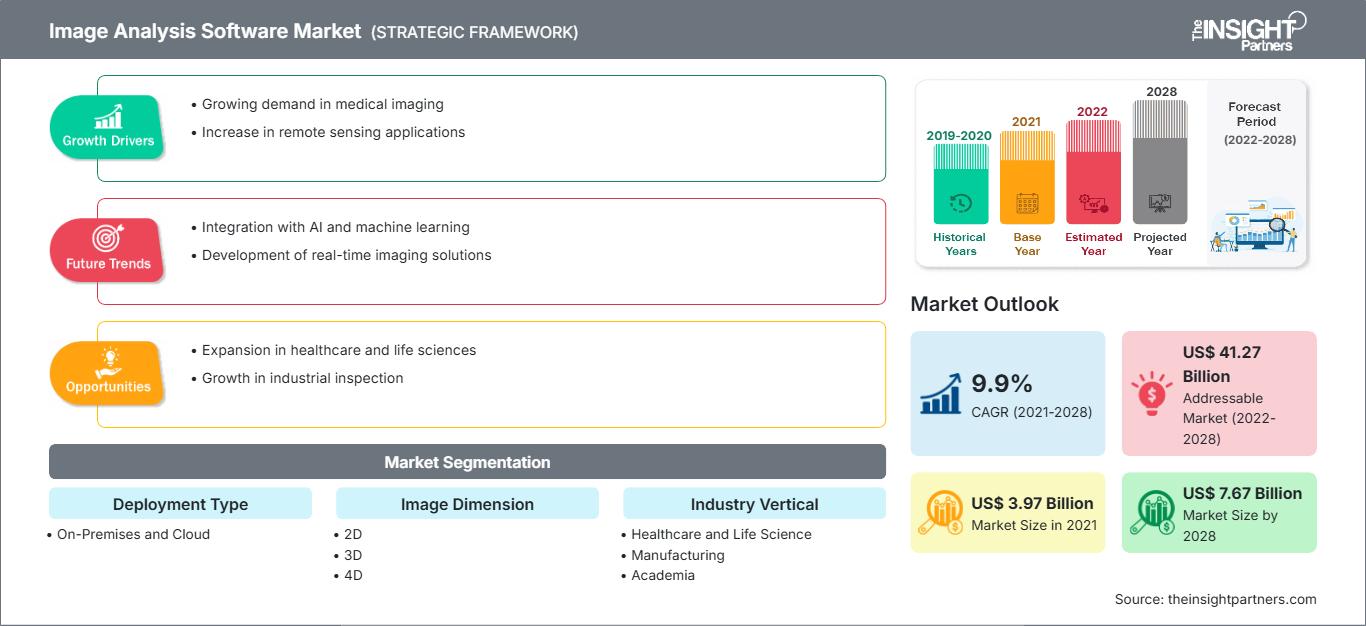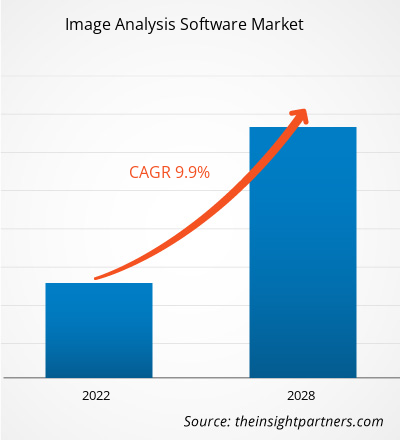[연구 보고서] 이미지 분석 소프트웨어 시장은 2021년 39억 7,093만 달러에서 2028년 76억 7,216만 달러로 성장할 것으로 예상되며, 2021년부터 2028년까지 연평균 9.9% 성장할 것으로 예상됩니다.
이미지 분석 소프트웨어 시장은 흔히 이미지 분석 시장이라고도 불리며, 디지털 이미지 처리 기술을 사용하여 사진, 특히 디지털 이미지에서 귀중한 데이터를 추출하는 데 도움을 줍니다. 이미지 분석 작업은 바코드 태그 스캔처럼 간단한 것부터 사람의 얼굴 인식처럼 복잡한 것까지 다양합니다. 컴퓨터는 방대한 양의 데이터를 처리해야 하며, 복잡한 컴퓨팅과 정량적 데이터 추출이 필요한 작업도 포함됩니다. 컴퓨터 또는 전기 장비가 사진을 분석하여 유용한 정보를 추출하는 것을 디지털 이미지 분석 또는 컴퓨터 이미지 분석이라고 합니다. 패턴 인식, 디지털 기하학, 신호 처리를 컴퓨터 또는 머신 비전과 의료 영상 분야에 통합합니다. 인공지능(AI)과 머신 러닝(ML) 기반 이미지 분석 소프트웨어 애플리케이션은 자동차 산업을 새롭게 정의합니다. 현재 자동차 제조 산업의 설계, 공급망, 생산 및 후반 작업 과정에서 사용되고 있습니다. 더 나아가 AI와 머신 러닝은 '운전 지원' 및 '운전자 위험 평가' 시스템에 사용되어 운송 산업에 혁명을 일으키고 있습니다. 인공지능은 예측 정비 및 보험과 같은 다양한 애프터마켓 서비스에도 변화를 가져오고 있습니다. 자동차 산업에서 머신 러닝은 새로운 지능형 제품 개발과 작업 방식 개선으로 이어졌습니다. 형상 찾기, 모서리 인식, 노이즈 감소, 물체 개수 계산, 질감 분석 또는 화질 통계 생성 등은 모두 이미지 분석 작업의 예입니다. 이미지 분석은 디지털 이미지를 2차원(2D) 또는 3차원(3D)으로 정량적 또는 정성적으로 특성화하는 작업으로, 컴퓨터 비전은 2D 이미지를 분석하고 의료 영상은 3D 이미지를 분석합니다. 이미지 분석 소프트웨어는 현미경 이미지 분석 및 과학적 이미지 연구에 널리 사용됩니다. 이미지 분석 소프트웨어 시장 성장은 주로 의료 및 생명 과학 산업에서 소프트웨어가 널리 채택된 데 따른 것입니다.
이 보고서의 일부, 국가 수준 분석, Excel 데이터 팩을 포함하여 모든 보고서에 대한 사용자 정의를 무료로 받을 수 있을 뿐만 아니라 스타트업 및 대학을 위한 훌륭한 제안 및 할인을 이용할 수 있습니다
이미지 분석 소프트웨어 시장: 전략적 통찰력

- 이 보고서의 주요 주요 시장 동향을 확인하세요.이 무료 샘플에는 시장 동향부터 추정 및 예측에 이르기까지 데이터 분석이 포함됩니다.
COVID-19 팬데믹이 이미지 분석 소프트웨어 시장에 미치는 영향
COVID-19 팬데믹은 이미지 분석 소프트웨어 시장에 긍정적인 영향을 미쳤습니다. 기업들은 COVID-19 팬데믹과 원격 근무 환경의 확산으로 새로운 어려움에 직면하고 있습니다. COVID-19 발생은 다양한 산업 분야의 기업들이 디지털 기술을 도입하고 이미지 분석 소프트웨어 시장 솔루션 및 서비스의 잠재력을 활용하여 운영 및 비용을 최적화해야 할 필요성을 부각시켰으며, 이는 IT 도구에 대한 투자 수익률(ROI)을 더욱 높일 것입니다. 더욱이, 2020년 팬데믹의 도래는 글로벌 이미지 분석 소프트웨어 시장 운영에 많은 어려움을 야기했습니다. COVID-19 확진자 증가로 선진국의 의료 인프라가 붕괴되었습니다. 따라서 공중 보건 비상사태는 정부와 시장 참여자들이 개입하여 예측 기간 동안 손실을 회복하기 위해 수행된 연구 개발 이니셔티브의 협력을 통해 이미지 분석 소프트웨어 시장 운영 및 수익 회복을 지원해야 함을 의미합니다. 또한, 투자 증가는 향후 몇 년간 이미지 분석 소프트웨어 시장에 긍정적인 영향을 미칠 것으로 예상됩니다.
이미지 분석 소프트웨어 시장 분석: 이미지 분석 기반 보안 애플리케이션 및 제품에 대한 수요 증가
기업들은 비정형 데이터에서 리소스를 추출할 수 있는 잠재력을 인지하기 시작했습니다. 기업들은 사진이나 비디오를 활용하여 소매, 엔터테인먼트, 보험 청구 및 기타 산업 분야에서 독특하고 매력적인 소비자 경험을 제공할 수 있습니다. 이미지 분석은 점점 더 많은 기업 활용 사례를 지원하는 데 활용되고 있습니다. 이러한 딥 러닝 및 이미지 분석의 실용적인 적용은 머신 러닝 알고리즘의 발전, 데이터 세트의 가용성, 그리고 실시간 처리를 지원하는 플랫폼을 갖춘 강력한 기술의 존재에서 비롯됩니다. 미국의 많은 공항들은 지문이나 홍채 스캔과 같은 생체 인식을 대체 보안 검색 기술로 활용할 수 있도록 장비를 업그레이드하고 있습니다. 기업들은 승객을 도착 게이트에서 보안 검색대를 거쳐 출발 게이트까지 이동시키는 데 이미지 분석 기술을 도입하여 처리 용량을 크게 늘릴 것으로 예상합니다.
이미지 분석 소프트웨어 시장 - 배포 유형별 세그먼트 분석
이미지 분석 소프트웨어 시장은 배포 방식에 따라 온프레미스와 클라우드로 구분됩니다. 온프레미스 소프트웨어는 서버 팜이나 클라우드와 같은 원격 시설이 아닌 사용자 또는 조직의 사내 컴퓨터에 설치 및 운영됩니다. 온프레미스 소프트웨어는 더 나은 유연성, 안정성 및 보안을 제공하므로, 여러 시장 참여자가 온프레미스 소프트웨어를 판매하고 있습니다. 예를 들어, 온프레미스 Imagga의 시각 AI 솔루션은 회사의 프라이빗 로컬 서버에 완벽하게 배포할 수 있습니다. 데이터에 민감한 조직은 Imagga의 수상 경력에 빛나는 시각 AI 기술을 사용하여 개인정보 보호법 및 규정을 완벽하게 준수하면서 자동 태그 지정, 자동 분류, 색상 추출, 맞춤형 학습 및 얼굴 인식을 수행할 수 있습니다.
이미지 분석 소프트웨어 시장 - 이미지 크기 세그먼트 분석
이미지 크기를 기준으로 이미지 분석 소프트웨어 시장은 2D, 3D, 4D로 구분됩니다. 2D 이미지는 x축과 y축을 사용하여 생성됩니다. 전통적으로 2D 이미지는 애니메이션과 비디오 소스로 사용되어 왔습니다. 오랜 역사를 가진 오래된 기술이지만, 여전히 고전적인 기술로 자리매김하는 데에는 이유가 있습니다. 이러한 이미지는 단순하고 시각적으로 매력적이며, 고객에게 지나치게 부담스럽거나 방해가 되지 않으면서도 사용하기 쉽습니다. 2D 이미지는 애니메이션과 비디오 게임에서 흔히 사용되는데, 화면에서 움직임을 사실적이면서도 평평한 관점으로 보여주기 때문입니다. 따라서 업계의 여러 기업들이 2D 사진 분석 소프트웨어를 제공하고 있습니다. 예를 들어, Media Cybernetics, Inc.의 Image-Pro Plus 2D 이미지 분석 소프트웨어는 간편하게 사진을 수집하고, 항목을 개수, 측정, 분류하고, 작업을 자동화할 수 있도록 지원합니다. 현미경 제어, 이미지 캡처, 측정, 개수/크기 조정, 매크로 개발 기능이 모두 이 소프트웨어 패키지에 포함되어 있습니다.
이미지 분석 소프트웨어 시장 - 산업별 세부 분석
산업별 세부 분석을 기준으로 이미지 분석 소프트웨어 시장은 의료 및 생명 과학, 제조, 학계, 광물, 금속 및 석유 등으로 세분화됩니다. 의료 산업에서 이미지 분석 소프트웨어는 신경학, 심장학, 정형외과, 치과, 종양학 등 다양한 분야에서 유용하게 사용됩니다. 이 소프트웨어는 X선, MRI, CT 스캔, PET 스캔, 초음파로 생성된 이미지를 판독할 수 있습니다. 따라서 프로세스를 자동화하고 가속화하여 수작업을 줄이고 시간을 절약할 수 있습니다. 또한, 소프트웨어는 이러한 사진의 특정 특징을 인식하는 방법을 학습하여 진단 절차를 빠르고 정확하게 수행할 수 있습니다. 의료 이미지 처리 소프트웨어는 다양한 기능을 제공합니다. AI 기반 솔루션은 불규칙성과 잠재적으로 위험한 이상을 감지하고 환자가 암인지 양성 종양인지도 알려줍니다. 이 소프트웨어는 일반 2D 이미지(시간에 따른 변화를 표시하는 이미지) 외에도 3D 및 소위 4D 사진을 판독할 수 있습니다.
이미지 분석 소프트웨어 시장
이미지 분석 소프트웨어 시장 참여자들은 경쟁 우위를 위해 첨단 기술과 기능을 통합하여 신제품 혁신 및 개발에 집중합니다. 2021년 10월, Clemex Vision은 마르텐사이트, 페라이트, 오스테나이트 입자에 대한 고유한 지침과 머신러닝 기능을 추가했습니다. 이러한 새로운 자동화 기능은 기존 소프트웨어 도구 상자에 추가되어 까다로운 미세 구조를 시각적으로 빠르고 정확하게 식별하는 기술을 제공합니다.
배포 유형에 따라 이미지 분석 소프트웨어 시장은 온프레미스와 클라우드로 구분됩니다. 이미지 크기에 따라 이미지 분석 소프트웨어 시장은 2D, 3D, 4D로 세분화됩니다. 이미지 분석 소프트웨어 시장은 산업별로 의료 및 생명 과학, 제조, 학계, 광물, 금속 및 석유, 기타 등으로 세분화됩니다. 지역별로는 북미, 유럽, 아시아 태평양, 중동 및 아프리카, 남미로 세분화됩니다.
이미지 분석 소프트웨어 시장 지역별 통찰력
The Insight Partners의 분석가들은 예측 기간 동안 이미지 분석 소프트웨어 시장에 영향을 미치는 지역별 동향과 요인들을 면밀히 분석했습니다. 이 섹션에서는 북미, 유럽, 아시아 태평양, 중동 및 아프리카, 그리고 중남미 지역의 이미지 분석 소프트웨어 시장 부문 및 지역별 현황도 다룹니다.
이미지 분석 소프트웨어 시장 보고서 범위
| 보고서 속성 | 세부 |
|---|---|
| 시장 규모 2021 | US$ 3.97 Billion |
| 시장규모별 2028 | US$ 7.67 Billion |
| 글로벌 CAGR (2021 - 2028) | 9.9% |
| 이전 데이터 | 2019-2020 |
| 예측 기간 | 2022-2028 |
| 다루는 세그먼트 |
By 배포 유형
|
| 포함된 지역 및 국가 | 북미
|
| 시장 선도 기업 및 주요 회사 프로필 |
|
이미지 분석 소프트웨어 시장 참여자 밀도: 비즈니스 역학에 미치는 영향 이해
이미지 분석 소프트웨어 시장은 소비자 선호도 변화, 기술 발전, 그리고 제품 이점에 대한 인식 제고 등의 요인으로 인한 최종 사용자 수요 증가에 힘입어 빠르게 성장하고 있습니다. 수요가 증가함에 따라 기업들은 제품 및 서비스를 확장하고, 소비자 니즈를 충족하기 위한 혁신을 추진하며, 새로운 트렌드를 적극 활용하고 있으며, 이는 시장 성장을 더욱 가속화하고 있습니다.

- 을 얻으세요 이미지 분석 소프트웨어 시장 주요 주요 플레이어 개요
이미지 분석 소프트웨어 시장 – 회사 프로필
- ADCIS SA
- Bio-Rad Laboratories, Inc.
- Oxford Instruments
- Clemex Technologies, Inc.
- Media Cybernetics, Inc.
- MIPAR Software LLC
- Olympus Corporation
- Pax-it
- PerkinElmer, Inc.
- TissueGnostics GmbH
- Leica Microsystems GmbH
- MVTec Software GmbH
- Carl Zeiss AG
- Scale AI, Inc.
- Labelbox, Inc.
- V7 Ltd
- 과거 분석(2년), 기준 연도, CAGR을 포함한 예측(7년)
- PEST 및 SWOT 분석
- 시장 규모 가치/거래량 - 글로벌, 지역, 국가
- 산업 및 경쟁 환경
- Excel 데이터세트
최근 보고서
관련 보고서
사용 후기
구매 이유
- 정보에 기반한 의사 결정
- 시장 역학 이해
- 경쟁 분석
- 고객 인사이트
- 시장 예측
- 위험 완화
- 전략 기획
- 투자 타당성 분석
- 신흥 시장 파악
- 마케팅 전략 강화
- 운영 효율성 향상
- 규제 동향에 발맞춰 대응






















 무료 샘플 받기 - 이미지 분석 소프트웨어 시장
무료 샘플 받기 - 이미지 분석 소프트웨어 시장